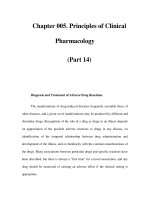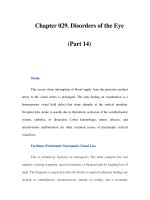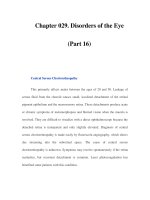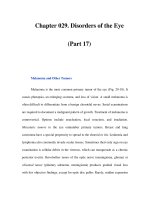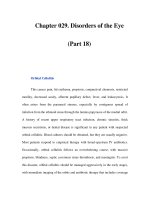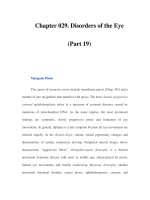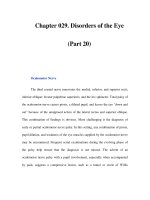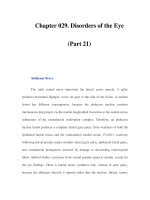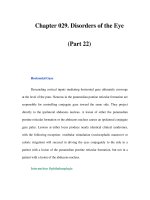Chapter 085. Neoplasms of the Lung (Part 14) pps
Bạn đang xem bản rút gọn của tài liệu. Xem và tải ngay bản đầy đủ của tài liệu tại đây (13.77 KB, 5 trang )
Chapter 085. Neoplasms of the Lung
(Part 14)
Superior Sulcus or Pancoast Tumors
Non-small cell carcinomas of the superior pulmonary sulcus producing
Pancoast's syndrome appear to behave differently than lung cancers at other sites
and are usually treated with combined radiotherapy and surgery. Patients with
these carcinomas should have the usual preoperative staging procedures, including
mediastinoscopy and CT and PET scans, to determine tumor extent and a
neurologic examination (and sometimes nerve conduction studies) to document
involvement or impingement of nerves in the region. If mediastinoscopy is
negative, curative approaches may be used in treating Pancoast's syndrome despite
its apparent locally invasive nature. The best results reported thus employed
concurrent preoperative irradiation [30 Gy in 10 treatments] and cisplatin and
etoposide, followed by an en bloc resection of the tumor and involved chest wall
3–6 weeks later; 65% of thoracotomy specimens showed either a complete
response or minimal residual microscopic disease on pathologic evaluation. The 2-
year survival rate was 55% for all eligible patients and 70% for patients who had a
complete resection.
NSCLC with T3, N0 Disease (Stage IIB)
The subset of T3, N0 disease (which does not present as Pancoast tumor)
was initially considered stage III disease. However, it has a different natural
history and treatment strategy than stage III N2 disease and is now considered as
stage IIB. Patients with peripheral chest wall invasion should have resection of the
involved ribs and underlying lung. Chest wall defects are then repaired with chest
wall musculature or Marlex mesh and methylmethacrylate. Five-year survival
rates as high as 35–50% have been found, and adjuvant chemotherapy is usually
recommended.
NSCLC Stage III
Treatment of locally advanced NSCLC is one of the most controversial
issues in the management of lung cancer. Treatment options include a local
therapy (surgery or radiation therapy) combined with systemic chemotherapy to
control micrometastases. Interpretation of the results of clinical trials involving
patients with locally advanced disease has been clouded by a number of issues,
including changing diagnostic techniques, different staging systems, and
heterogeneous patient populations with tumors that range from nonbulky stage
IIIA (clinical N1 nodes with N2 nodes discovered only at the time of surgery,
despite a negative mediastinoscopy) to bulky N2 nodes (enlarged adenopathy
clearly visible on chest x-rays or multiple nodal level involvement) to clearly
inoperable stage IIIB disease. Thus, a team approach involving pulmonary
medicine, thoracic surgery, and medical and radiation oncology is essential for the
management of these patients.
NSCLC Stage IIIA
Nonbulky IIIASurgery for N2 disease is a controversial area in the
management of lung cancer. Patients with N2 disease can be divided into
"minimal" disease (involvement of only one node with microscopic foci, usually
discovered at thoracotomy or mediastinoscopy) and the more common "advanced"
bulky disease, clinically obvious on CT scans and discovered preoperatively.
Patients who have an incidental finding of N2 disease at the time of resection
should receive adjuvant chemotherapy.
Bulky IIIA
No evidence suggests that patients with "bulky," multilevel ipsilateral
mediastinal nodes (N2) have improved survival with surgery and either pre- or
postoperative chemotherapy compared to treatment with chemotherapy plus
radiation therapy. This important issue was addressed in the multicenter
randomized Intergroup 0139 Trial involving patients with pathologically staged
N2 disease who received 45 Gy of induction radiation therapy plus two cycles of
cisplatin and etoposide to "debulk" tumors. The patients were then randomly
assigned to surgical resection of any residual tumor or to boost radiation therapy
plus an additional two cycles of chemotherapy. Although a significant
improvement in progression-free survival was observed at 5 years for those
patients randomized to surgical resection (22% vs. 11%; p = .017), the difference
in 5-year overall survival while favoring surgery (22% vs. 11%; p = .10) was not
significant. This is important since treatment-related mortality was greater in the
surgery arm (8% vs. 2%), with the majority of deaths occurring in patients
undergoing pneumonectomy. Patients who had persistent N2 disease following
neoadjuvant chemotherapy did particularly poorly, leading some oncologists to
conclude that surgery for bulky IIIA disease should only be conducted in patients
who have clearing of their mediastinal nodes following neoadjuvant therapy. The
main role of neoadjuvant chemotherapy is to control micrometastatic disease, and
if this macroscopically evident disease is not sensitive to chemotherapy, it is
unlikely that the microscopic disease will be controlled. Thus, surgical removal of
the primary tumor after such chemotherapy is probably fruitless. Likewise,
neoadjuvant chemotherapy generally should not be used to render inoperable
disease operable. One exception to this approach is T4, N0 or T4, N1 (stage IIIB,
see below) disease for which preoperative chemotherapy may provide enough
tumor debulking to allow otherwise unresectable disease to be resected.
Chemotherapy may allow chest wall resection for direct extension of tumor,
tracheal sleeve pneumonectomy, and sleeve lobectomy for lesions near the carina.
